DO-IT News December 2013

Volume 21, Number 4
Below are the articles of the DO-IT News December 2013 newsletter. These articles can also be seen all on one page at the Full Newsletter option.
Director's Digressions: The Thread
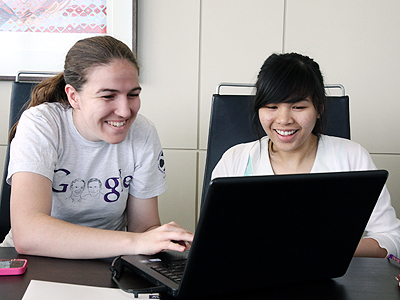
I wanted to share with you a question posed by program staff on one of our discussion forums so that you can get the flavor of the many rich conversations the DO-IT community has online. Some responses have been edited for clarity and brevity.
There's a great article about how to use LinkedIn as a college student here: mashable.com/2013/08/12/linkedin-college-students. What do you think of the advice? How has LinkedIn been useful for you?
AccessTeam Member: As a college instructor, I get flooded with requests from former students, many of whom I might never have interacted with (especially if it was a large class). My advice is to please not do this unless you communicate first with your instructor and get permission. Otherwise, it's like listing a person as a reference without asking them. You can do it, but there can be repercussions.
AccessTeam Member: One factor to keep in mind is that one of the things LinkedIn tries to get users to do as part of the account creation process is "automatically" adding their contacts. When a user authorizes this, it automatically scrapes any email accounts you happen to be logged in to, and sends automatic invitations to all or some subset of email addresses that you have sent to. I tend to get at least one or two random connection requests a week from people that sent me an email or two years ago and I haven't interacted with since.
AccessTeam Member: I've been a part of a few discussions where people seem to forget the site is aimed at building career connections and they say inappropriate things that would not make them look good in front of prospective employers. You have to remember who your audience is and whether what you say might be a deal-breaker for a potential employer. For example, do not go on LinkedIn and trash your previous employers and supervisors. Potential employers will see that as a red flag and you will have burned a bridge before you even knew you wanted to cross it.
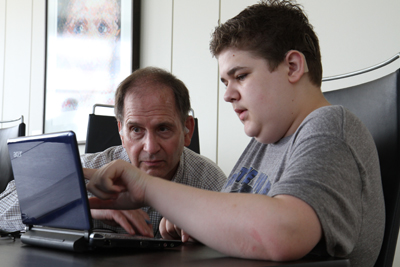
AccessComputing Member: I just got on LinkedIn and connected with an old friend. He's working in the financial sector, and I am doing my Ph.D. in computer science. The first thing he said was that he could use my computer skills for his big data problems. You never know who is doing what out there, and how it could relate to you.
A career counselor once told me that eighty percent of job openings are never posted. It's all done through friends and family connections. The last two jobs I have had were referrals through both a friend a professor. So I think LinkedIn is great, and I wish I had started on it sooner.
AccessComputing Member: LinkedIn is just another of the tools that I use to communicate with people. Every job I have had since high school, I got through a connection. I have several hundred people that I am connected to, and I readily use the list to find people with certain skill sets when I need something done.
DO-IT Staff Member Recognized by Washington State Governor Jay Inslee
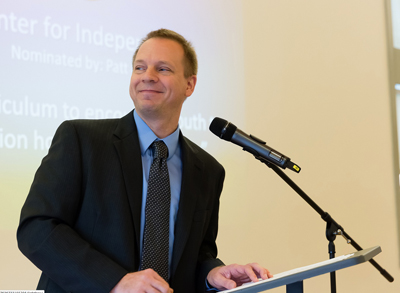
On October 18, DO-IT program manager Scott Bellman received an award from the Governor's Committee on Disability Issues and Employment (GCDE) on behalf of Washington State Governor Jay Inslee for "steady leadership skills and tireless commitment" in his work to recognize best practices in the employment of people with disabilities in Washington State.
Scott has served as chair of the GCDE's Employer Awards Program for several years. The annual program recognizes and promotes the achievements of employers and individuals who have improved employment opportunities for people with disabilities in Washington State.
Scott has also served as a member of the Coordinating Committee for the GCDE, which promotes equality, opportunity, independence and full participation in life for people with disabilities. The GCDE:
- Advises Governor Inslee, the legislature, and state agencies on policies that affect people with disabilities.
- Promotes understanding of the needs and potential of people with disabilities, offering information and awareness training to the public.
- Provides training and technical assistance to the business community to promote employment opportunities and awareness of disability issues.
- As a program manager at DO-IT, Scott provides leadership for programs that promote the full inclusion of people with disabilities in challenging academic programs and careers.
New AccessComputing Website
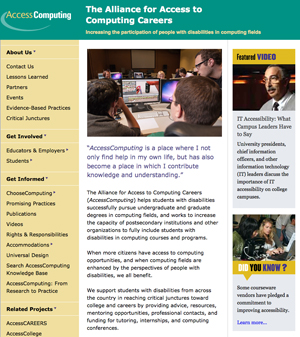
AccessComputing has just launched a redesigned website with a new look and feel as well as new navigation, search capability, content, and features. Take a look at www.uw.edu/accesscomputing.
The new Choose Computing (www.uw.edu/accesscomputing/get-informed/why-choose-computing) encourages high school students with disabilities to pursue computing and IT careers. There you'll find profiles of successful computing students and professionals who happen to have disabilities, resources to learn more about careers in computing, and examples of computing projects.
With the new website, we've also launched our AccessComputing Replication Packages (www.uw.edu/accesscomputing/get-involved/educators-employers/replication-packages). These publications provide information and resources that can be used to replicate activities that have been successful in supporting AccessComputing's goals of increasing the participation of individuals with disabilities in computing and IT fields. You can learn about camps and activities for students as well as trainings designed for professionals.
Dis-course: Disability Representation and the Media, Part One
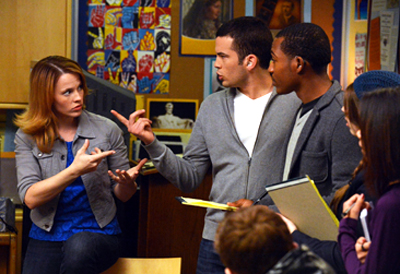
When I asked my Facebook friends to make a list of characters with disabilities in the media, I got a wide range of answers spanning from Artie who appears on Glee to Tyrion from Game of Thrones. With so many examples across genres and formats, you would think that people with disabilities are adequately represented in the media.
But what is "representation"? Is it purely a numbers game, or is it more than that? Media representation is the ways in which the media portrays particular groups, communities, and experiences. This includes the accuracy of portrayals, the diversity of perspectives, and whether those portrayals perpetuate negative stereotypes. It's not just about quantity—it's about quality.
The sad fact is that there are very few characters on television that openly identify as being disabled—1% according to Where We Are On TV 2011, GLAAD's annual report about diversity on television. That dismal statistic is a problem on its own, but it only scratches the surface.
The characters with disabilities we do see on TV are typically white males. In addition to the lack of racial and gender diversity, many disabled characters are fueled by stereotypes of "overcoming" their disability or being inspirational to others. While there is nothing wrong with a character being an inspiration to others, it should not be the only purpose that they serve in the narrative. Here's a test to see if a disabled character actually has a purpose beyond their disability; replace the disabled character with an able-bodied one. Does this character have a story, goals, relationships, and interests? If they don't, we have a problem.
The TV show Switched at Birth is a positive example. It has featured many individuals with hearing impairments and has aired an entire episode in ASL (American Sign Language). One of the reasons I love this show is that one of the main characters is hearing impaired, but that is not her main story arc. She is a high school student who plays sports, is engaged politically, and aspires to be a chef. Her three-dimensionality makes her a more accurate representation of a person with a disability: She is much more than her deafness.
Of course, there are many negative examples in the media, like Glee. The reason I'm on Glee is because the show boasts at being highly diverse and forward thinking. They have many people of color on their cast, and even showcase some characters that have disabilities. Artie, for example, is a high school student who uses a wheelchair. The reason his plotline is problematic is because he always longs to be able to dance. Instead of the writers using this part of his character to, you know, develop his character (i.e., let Artie learn he can dance while also using a wheelchair), they come up with a dream sequence where Artie gets up out of his chair and dances as an able-bodied person. This just perpetuates the idea that people with disabilities can only achieve happiness if they are "normalized" or "cured" of their disability.
If we can accomplish better quality and quantity of disability representation in the media, we start exposing the world to more realistic experiences of individuals with disabilities. We can begin a true dialogue about disability and create points of reference for doing so. In this way, TV and film characters have the potential to change the dominant discourse and attitudes within society. They can help bridge divides and break away from stereotypes.
The next installment of Ms. Brown's multi-part series will appear in the next issue of DO-IT News.
Finding Financial Aid and Scholarships
Attending college can be an exciting and enriching experience. It can also be a costly one, from tuition and books to health insurance and transportation. A combination of financial aid and other outside funding resources can help you meet college costs.
The first step for most students seeking funding for college is the FAFSA (Free Application for Federal Student Aid). You can complete the FAFSA online at www.fafsa.ed.gov, but pay attention to deadlines. In Washington state, complete the application as soon as possible after January 1.
The DO-IT publication College Funding for Students with Disabilities includes information on federal aid programs, Social Security Income, and Division of Vocational Rehabilitation services, along with loans, grants, and scholarships. You can find it online at College Funding for Students with Disabilities.
For scholarship information you can brows by disability type, try the DO-IT Scholarships web page at Scholarships. Below are a few free online resources you might with to explore:
- FastWeb (www.fastweb.com) has a scholarship matching service.
- theWashBoard.org (washboard.wsac.wa.gov/login.aspx) connects Washington students with Washington scholarships.
- Scholarship Junkies (www.scholarshipjunkies.org/) connects scholarship-winning students with scholarship applicants in order to help students learn how to best articulate their talents, skills, and life stories through their own personal scholarship application process.
DO-IT Collaboration with the Center for Neurotechnology
Over the last decade, the field of neural engineering has demonstrated to the world that a computer cursor, a wheelchair, or a prosthetic limb can be controlled using direct brain-machine and brain-computer neural signals. That means using your brain to control things in your environment. The Center for Neurotechnology (CNT), located in Russell Hall on the University of Washington campus, collaborates with partner universities and with DO-IT to facilitate advances in this exciting field. The CNT has hosted DO-IT students as interns, summer researchers, facility consultants, and website accessibility experts. We have also hosted three large workshops at the CNT.
DO-IT students who are interested in neural engineering and brain-computer interface can visit the CNT website at www.csne-erc.org. The next DO-IT event at the CNT, on February 7, 2014, is open to all DO-IT students, Ambassadors, and Mentors. For more information about DO-IT's partnership with the CNT, contact Scott Bellman at swb3@uw.edu or 206-685-3648 (v/TTY).
Tech Tips: Don't Forget the Optional Updates
Most people know about running Windows Update, which protects their machines by installing recent updates to the Windows operating system and hardware to fix security vulnerabilities. People may have their machines set to automatically download and install critical updates as a background process.
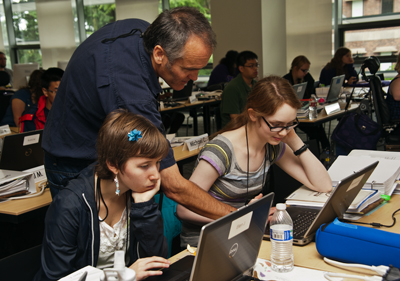
What many people don't know is that when manually running Windows Update, there is a subsection of the process that reveals non-critical "optional updates." These include updates to devices like the video card, sound card, and Ethernet card.
If you go into Control Panel, run Windows Update, and pick the "check for updates" option, your computer will connect to Microsoft to reveal updates that are available, placing the critical or important ones front and center. After installing those and restarting the machine, run Windows Update again and look for the "optional updates" link.
There you'll see a list of items that although not deemed critical, can be of benefit to the user if it improves the performance of your hardware devices.
Click the checkbox next to available updates and run the installer for those. You may find that the screen may flicker when installing new video card drivers. In the case of wireless or Ethernet adapter updates, the system may lose connectivity briefly before re-connecting.
Check to see what new drivers may be available for your system.
Call For Articles
DO-IT is pleased to announce the development of a new online resource: a place to cumulate emerging examples of universal design applied in postsecondary education, as complement to the book, Universal Design in Higher Education: From Principles to Practice, published by Harvard Education Press (www.hepg.org/hep/Book/83). Articles should include specific ways practitioners and researchers have applied universal design in postsecondary settings along with evidence of success.
Articles will be peer-reviewed by members of the Universal Design in Higher Education Community of Practice (udhecop@uw.edu), and if accepted, edited by DO-IT Founder and Director Sheryl Burgstahler. Articles selected for the online resource will be available free on our website. Authors will agree to these conditions while retaining copyrights to their individual contributions.
Articles may be submitted at any time to udhecop@uw.edu. For author guidelines, contact doit@uw.edu.
Scholar Profiles: Paralympians
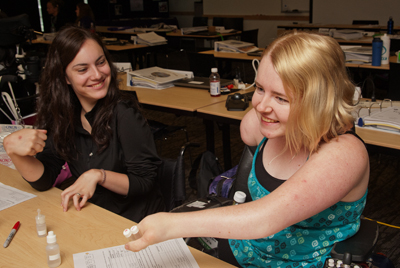
As C.S. Lewis says, "friendship is born at that moment when one person says to another: 'What! You too? I thought I was the only one.'" From childhood through becoming paralympians and participating in DO-IT programs, we have stayed close friends throughout our life.
Our friendship started at Little Red School House, a pre-preschool program for kids with disabilities, when we were less than a year old. In elementary school, we both joined the local Paralympic swim team known as the Shadow Seals. We traveled to a couple of swim meets around the United States, including the 2008 Junior Nationals in New Jersey.
The following year, we attended Camp Access, a summer camp for children with disabilities. The camp director took all over-thirteen campers over to a shooting range for the day.Once we were comfortably settled behind the sights of a .22 rifle, we started one of our normal competitive streaks. We were surprised about how well we did, considering it was our first time shooting.
From there, McKenna decided to pursue shooting while Kayla still competed as a swimmer. Today, we are highly ranked in our respective sports and have both been to many international competitions, including a few world championships.
McKenna
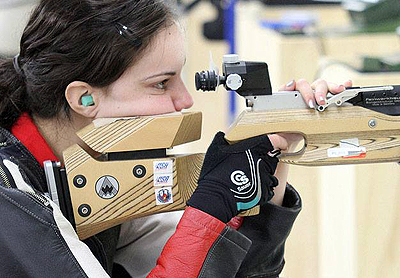
After my first time shooting at Camp Access, the camp director invited me to shoot at a local air rifle match he was hosting. After the match was over, I looked at the posted results in shock. I was ranked right up with some shooters that had been shooting for years, and I had only shot an air rifle four times in my life. That match qualified me to attend a Paralympic Training Camp at the Olympic Training Center in Colorado Springs, CO. I received training from the Paralympic coach and met some shooters who forever changed my life. From there, my shooting career took off.
Since 2010, I have been to the Training Center three times, competed at the USA Shooting National Championships twice, and as of June 2013, I am a member of the United States Paralympic National Development Team. This year, I have started travelling internationally as well. In Austria I competed in my first international competition, where I brought back five gold medals for Team USA. In Poland, I placed within the top fifteen shooters in both of my events. In Great Britain, I placed fifth in my standing event, earning a spot in the final. Most recently, at the Thailand World Cup, I placed seventh in my standing event, and after the final was over, my overall ranking was fifth. I then won the gold medal in the Falling Target match, which was an event I shot just for fun.
It seems crazy to me that three short years ago, I had just discovered Paralympic shooting. It opened my mind to the world and other cultures and is shaping me into the person I am today. Paralympic sports have taught me the importance of hard work, focus, and determination.
Kayla
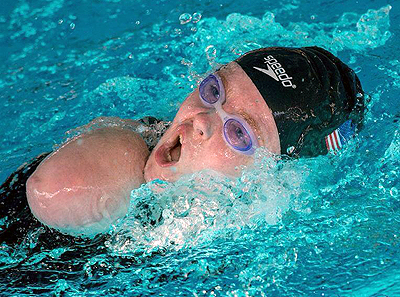
I've always enjoyed swimming. Since I was little, I liked the freedom the water gave me. It took away the restrictions of gravity and allowed me to do things I'd only dreamed of doing on land, like flips, handstands, cartwheels, and other things I can't physically do with one limb. In kindergarten, my mom heard through the grapevine that my teacher was also a swim instructor, and my mom approached her, asking if she'd be willing to give me lessons. She said yes, and I still swim with her and her twin sister today.
Several years later, I'm still swimming. I am still a part of the Shadow Seals, but I am also on the National Team. I have been to three world championships—in the Netherlands, Brazil, and Canada—and I've competed in the Parapan American Games in Mexico. I currently hold thirty two national records and three world records. Swimming is one of my favorite things to do, and I can't see myself stopping any time soon.
I love that even though we are in different sports, McKenna and I have both found a sport that makes us happy, but also lets us be competitive with each other. We are both working towards our goal of making it to the 2016 Paralympics in Rio de Janeiro.
DO-IT
Due to our crazy sport schedules, neither of us knew that the other had applied to be a DO-IT Scholar until we called to catch up after an eventful spring break. One of us mentioned our acceptance into a "cool college prep program at the UW" and the conversation exploded. The next day, we were both contacting Tami, program coordinator in charge of Summer Study, asking her if we could be roommates. A few short months later, we rolled into our dorm room, prepared for an amazing ten days at the UW.
During our time at DO-IT, we were thrown together with other teenagers with disabilities from all over the state. Brief introductions were given at the beginning of the camp, and a few icebreakers were played with the other Scholars. No more than a few hours later, seventeen strangers, brought together by their differences, were adopted into the DO-IT family. We know that we will be a part of this family for the rest of our lives and that they will be our support system through our college years and beyond. We look forward to seeing DO-IT change the lives of many bright, ready-to-learn Scholars next year, when we are in Phase II.
How Can You DO-IT?
- Sign up to receive DO-IT News if this newsletter was not mailed directly to you.
- Volunteer as a Mentor or to help with one of our Summer Study programs.
- Pass this newsletter on to someone you know who can benefit from our programs.
- Donate money to support and extend DO-IT activities including sponsoring Scholars from states outside of Washington, special events, work-based learning experiences, participant attendant or travel costs, refreshments for program participants, and creation and distribution of educational videotapes and publications.
DO-IT today by completing the form below! You may also make a secure online credit card donation at the University of Washington Make a Gift page by selecting the "DO-IT Program Gift Fund" option.
___ Sign me up to receive copies of DO-IT NEWS, a free program newsletter.
___ Send me more information about DO-IT volunteer opportunities.
___ I would like to make a donation (payable to the University of Washington, Federal ID#91-6001537) to support DO-IT operations.
___ I have enclosed a check for $____________
___ Please charge $____________ to my credit card.
___ VISA ___ Mastercard
Date _____________
Card Number __________________________ Expiration Date _____________
Card Holder Name ___________________________________________________
Signature _____________________________________________________
Address ____________________________________________________________
City __________________________ State _____________ Zip ____________
Phone: Home __________________________ Business ____________________
E-mail: ____________________________________________________________
Your gift is tax-deductible as specified in IRS regulations. Pursuant to RCW 19.09, the University of Washington is registered as a charitable organization with the Secretary of State, State of Washington. For more information, call the Office of the Secretary of State, 1-800-322-4483.
Mail to:
DO-IT
University of Washington
Box 354842
Seattle, WA 98195-4842
Thank you!
About DO-IT
DO-IT News is published at the University of Washington with input from DO-IT staff, Pals, Scholars, Ambassadors, and Mentors. DO-IT is primarily funded by the National Science Foundation, the U.S. Department of Education, and the State of Washington.
DO-IT (Disabilities, Opportunities, Internetworking, and Technology) serves to increase the successful participation of individuals with disabilities in challenging academic programs such as those in science, engineering, mathematics, and technology. Primary funding for DO-IT is provided by the National Science Foundation, the State of Washington, and the U.S. Department of Education. DO-IT is a collaboration of UW Information Technology and the Colleges of Engineering and Education at the University of Washington.
Grants and gifts fund DO-IT publications, videos, and programs to support the academic and career success of people with disabilities. Contribute today by sending a check to DO-IT, Box 354842, University of Washington, Seattle, WA 98195-4842.
Your gift is tax deductible as specified in IRS regulations. Pursuant to RCW 19.09, the University of Washington is registered as a charitable organization with the Secretary of State, state of Washington. For more information call the Office of the Secretary of State, 1-800-322-4483.
To order free publications or newsletters use the DO-IT Publications Order Form; to order videos and training materials use the Videos, Books and Comprehensive Training Materials Order Form.
For further information, to be placed on the DO-IT mailing list, request materials in an alternate format, or to make comments or suggestions about DO-IT publications or web pages contact:
DO-IT
University of Washington
Box 354842
Seattle, WA 98195-4842
doit@uw.edu
www.uw.edu/doit
206-685-DOIT (3648) (voice/TTY)
888-972-DOIT (3648) (voice/TTY)
206-221-4171 (fax)
509-328-9331 (voice/TTY)
Spokane Founder and Director: Sheryl Burgstahler, Ph.D.